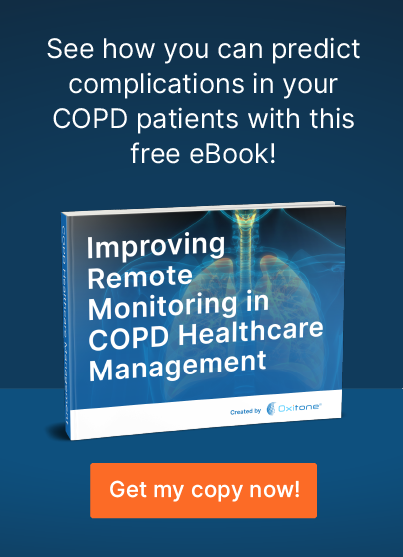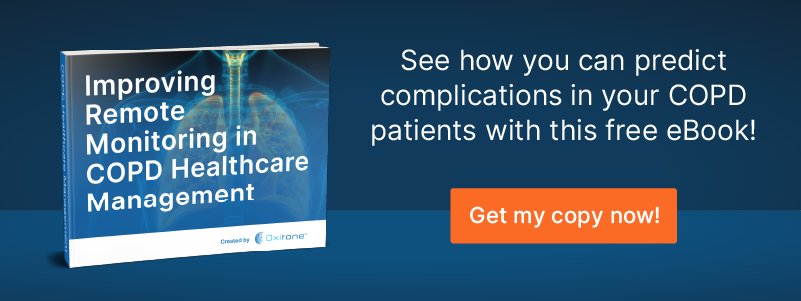Treating COPD and Digital Patient Engagement with the Oxitone 1000M
The digitization of the medical field, particularly through the advent of continuous remote patient monitoring (CRPM), is rapidly becoming a best-practice for the treatment of COPD. With continuous monitoring, COPD and digital patient engagement has never been more achievable, accurate, and efficient.
Considering that patient engagement is crucial for quality of life and a more streamlined medical practice, wearable medical devices align with many physicians’ demands for proper long-term care of COPD. The Oxitone 1000M was designed specifically to meet these needs by:
- Anticipating complications
- Providing more accurate recommendations for behavior modification
- Enabling enhanced patient compliance
Let’s look at the essentials of a long-term care strategy for high-risk COPD patients and how CRPM wearable devices like the Oxitone 1000M improve long-term care.
The Essentials of Long-Term Care Strategy for COPD Patients
Anticipating Complications
COPD patients need a physician’s guidance and oversight to avoid complications that result from this progressive disease. By tracking a patient’s vital signs over a long timeline through wearable CRPM devices (like the Oxitone 1000M), physicians have a clear outline to anticipate developing symptoms, drug interactions, exacerbating behaviors, etc. Patients benefit from enhanced quality of life and a reduction in visits to the ER or outpatient facilities.
Providing More Accurate Recommendations For Behavior Modification
There are several behaviors and activities that patients who suffer from COPD may need to mitigate in order to stay healthy during treatment. By having empirical reference points, a physician can interface with a patient through efficient data transfer through digital uploads from home or during in-person visitations to determine a patient’s current and projected capabilities.
For example, COPD patients who engage in regular physical labor, such as work or home maintenance responsibilities (e.g., lawn care, moving furniture, etc.), may need to scale back their daily efforts or eliminate them entirely for longevity. For high-risk patients who need to upgrade their disability status, CRPM devices enable physicians to accurately prescribe work/activity within the patient’s assessed abilities.
Enabling Enhanced Patient Compliance
New studies have shown that there is a direct link between wearable medical devices and patient adherence to prescribed treatments. With traditional methods of remote monitoring, patients with COPD are required to use fingertip oximeters to measure pulse rate, hypoxia, and other ailments. Data is then uploaded during visits to outpatient facilities or hospitals. However, lapses in data between visits may not account for patients who:
- Neglect to take prescribed medications
- Neglect to wear medical devices or take regular readings
- Regularly engage in exacerbating activities
- Consume food with poor nutritional value (e.g., foods high in sodium or cholesterol)
For COPD and digital patient engagement with CRPM wearable devices, physicians can accurately determine whether patients are wearing the device as prescribed. Lapses in prescribed behaviors can be assessed to create a better long-term health strategy for patients.
How Oxitone’s 1000M Improves Patient Care and Engagement
Wearable CRPM medical devices bridge the gap between patients who suffer from COPD and digital patient engagement with physicians. The Oxitone 1000M was designed specifically to replace traditional RPM methodologies and enhance medical care for at-risk patients.
The benefits of using the Oxitone 1000M for COPD include:
- Medical-specific design
- Continuous monitoring
- Clinical time optimization
- Reduce clinician overburdening
- Wearable comfort
- Patient care cost reductions
- Peace of mind
Medical-Specific Design
The 1000M is FDA-cleared for usage in the treatment of COPD and a variety of other diseases. Unlike other consumer-wearable devices, such as the Fitbit and AppleWatch, the Oxitone 1000M was specifically designed through rigorous testing to leverage the newest in artificial intelligence (AI), machine-learning, and Bluetooth Low Energy (BLE). Due to the nature of CRPM, a plethora of data is available to corroborate potential COPD risk factors.
By contrast, multi-use devices typically do not provide comprehensive, focused data reporting for patient health, particularly for high-risk COPD patients. These consumer devices have been the subject of many in-depth studies that often point to multi-use devices providing inaccuracies, false positives, and other confusing data that can negatively impact patient health.
Continuous Monitoring
As a progressive disease, COPD needs to be continually monitored. Thanks to CRPM, the Oxitone 1000M provides around-the-clock monitoring with no lapses in data accumulation. Episodic data, which categorizes traditional RPM, is no longer an issue.
Clinical Time Optimization
Because of the COVID-19 pandemic and the susceptibility of COPD patients to transmittable respiratory disease, clinical time optimization is top of mind for physicians and high-risk patients (particularly those in the advanced stages of COPD). To comply with the best guidelines set for at-risk patients, the Oxitone 1000M plays a critical part in reducing the time spent in clinic waiting rooms. The 1000M’s remote data transmission is also a significant factor in adhering to the CDC’s guidelines for social distancing.
Reduced Clinician Overburdening
Physicians looking to optimize their practice and prioritize patients who need regular care can prescribe the use of the Oxitone 1000M for event monitoring and tracing. Thanks to the 1000M’s continuous monitoring and connectivity with most medical systems, patients can avoid unnecessary visits and submit data without visiting the physician’s physical location.
Wearable Comfort
One of Oxitone 1000M’s key innovations is its FlexSense™ elastic optical aperture. Designed for accuracy and wearability, the adjustable aperture fits securely over the ulna bone with virtually no effect on local blood flow while maintaining excellent usability of the device. By contrast, finger-mounted pulse oximeters have proved cumbersome to wear for readings.
Patient Care Cost Reductions
With the average cost of hospitalization per day above $3,000 and an ambulance ride ranging from $400 to $1,200, high-risk COPD patients can mitigate costs by anticipating potential health risks or choosing more affordable transportation options before symptoms increase.
Peace of Mind
Continuous monitoring with the 1000M is an analog for ICU-based patient care. By wearing the device, patients can rest easy knowing that the 1000M has around-the-clock alerts for developing symptoms that point to potential flare-ups.
Achieve Optimized Digital Patient Management for COPD Treatment with the Oxitone 1000M
Physicians who provide optimal care need to understand the possibilities of COPD and digital patient engagement as provided by the Oxitone 1000M. CRPM enables better patient engagement and plays a pivotal role in treating COPD for the future of medical care.
For more information and specifications about the Oxitone 1000M, be sure to read the Oxitone 1000M medical brochure for answers to common questions related to this revolutionary wearable medical device for COPD.
Here at Oxitone, we boost value-based healthcare by delivering extraordinary patient, clinical, and economical outcomes at reduced medical utilization and cost. Patients need a prompt response to emergencies. Physicians need an easy and timely follow-up with patients. Our mission is to transform chronic disease management and help save lives worldwide.
Let’s save lives together! To see how we help remote patient monitoring companies and physicians improve the management and care of high-risk patients, contact us today!


